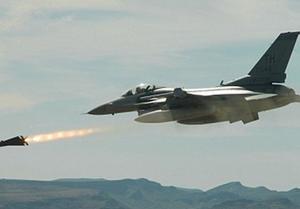SyriaIsrael, again, beats Syria’s air defense systems
The Tuesday night Israeli air attacks against targets in Syria raise questions about the effectiveness of the vaunted Syrian air defense system. By extension, similar questions should be asked about the effectiveness of the Iranian air-defense system: both systems use similar technology, and both come from Russia.

Israeli jets again penetrate Syrian aie defense system // Source: abna.ir
The Tuesday night Israeli air attacks against targets in Syria – including the destruction of a Syrian military convoy carrying advanced Russian SA-17 anti-aircraft missiles to Hezbollah in Lebanon, and the heavy damage done to the Syrian Scientific Studies and Research Center, the country’s main biological and chemical weapons research center – raise questions about the effectiveness of the vaunted Syrian air defense system. By extension, similar questions should be asked about the effectiveness of the Iranian air-defense system: both systems use similar technology, and both come from Russia:
The New York Times notes that “The ease with which Israeli planes reached the Syrian capital appeared to send a message — both to Mr. Assad and, indirectly, to Iran.”
Israel has not confirmed it was behind the attack, but the outgoing Israeli defense minister, Ehud Barak, who is attending a security conference in Munich, after initially saying that he could not “add anything to what you have read in the newspapers about what happened in Syria,” then added what happened in Syria Tuesday night was “another proof that when we say something we mean it.”
“We say that we don’t think it should be allowed to bring advanced weapon systems into Lebanon, to Hezbollah, from Syria when Assad falls.”
Dr. Dany Shoham, a senior research fellow at the Begin-Sadat Center for Strategic Studies at Bar-Ilan university in Israel and an expert on unconventional weapons, told the Times that the Syrian center’s “efforts concentrated first of all in upgrading chemical and biological war agents and, second, upgrading dispersal and delivery systems for those agents.”
“It’s a very large compound,” Shoham said. “You can imagine that it’s the principal facility of the whole Syrian Army that is responsible for developing, testing, upgrading, pilot production of a vast variety of weapons, both conventional and unconventional.”
This is not the first time Israel overcame Syria’s air defenses with relative ease. Two cases stand out:
- The 1982 Israeli invasion of Lebanon — what Israelis call the First Lebanon War – saw the largest air-to-air combat of the jet age, with more than 150 aircraft from both sides involved. It was a decidedly one-sided air war, however. In six days (6–11 June 1982) of aerial combat, Israel shot down eighty-six Syrian MiG-23s (6MF, 4MS, and 14BN), without losing a single plane.
On 9 June 1982, Israel launched Operation Mole Cricket-19, attacking the Soviet-made SAM missile batteries the Syrians deployed in the Beqaa Valley. The operation, using sophisticated technology, lasted only two hours, but at the end, seventeen of the nineteen Syrian missile batteries in the Beqaa Valley were destroyed. The operation was the first time a Western air force successfully destroyed a Soviet-built surface-to-air missile (SAM) network. - On 6 September 2007, Israeli planes destroyed a Syrian nuclear reactor being built in the Deir ez-Zor region in northeast Syria. Eight aircraft — F-15Is and F-16Is — equipped with AGM-65 Maverick missiles and 500 lb bombs entered Syria after flying east along the Syria-Turkey border. They dropped their munitions – and these munitions were guided to their target by a team of Israeli special-forces, who arrived at the nuclear plant’s vicinity the day before, and who beamed the target with lasers.
The most intriguing aspect of the operation was the ability of Israel, again, to overcome Syria’s elaborate air defense systems. In May 2008, the IEEE Spectrum, the authoritative engineering journal published by the Institute of Electrical and Electronics Engineers, published a report in which European sources said that the Syrian air defense network had been deactivated by a secret built-in kill switch activated by the Israelis.
